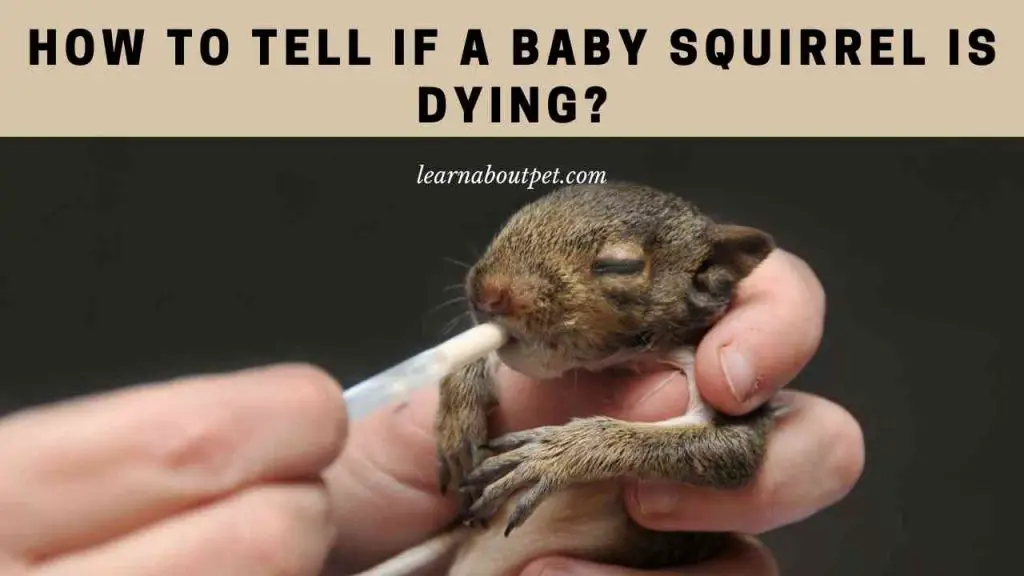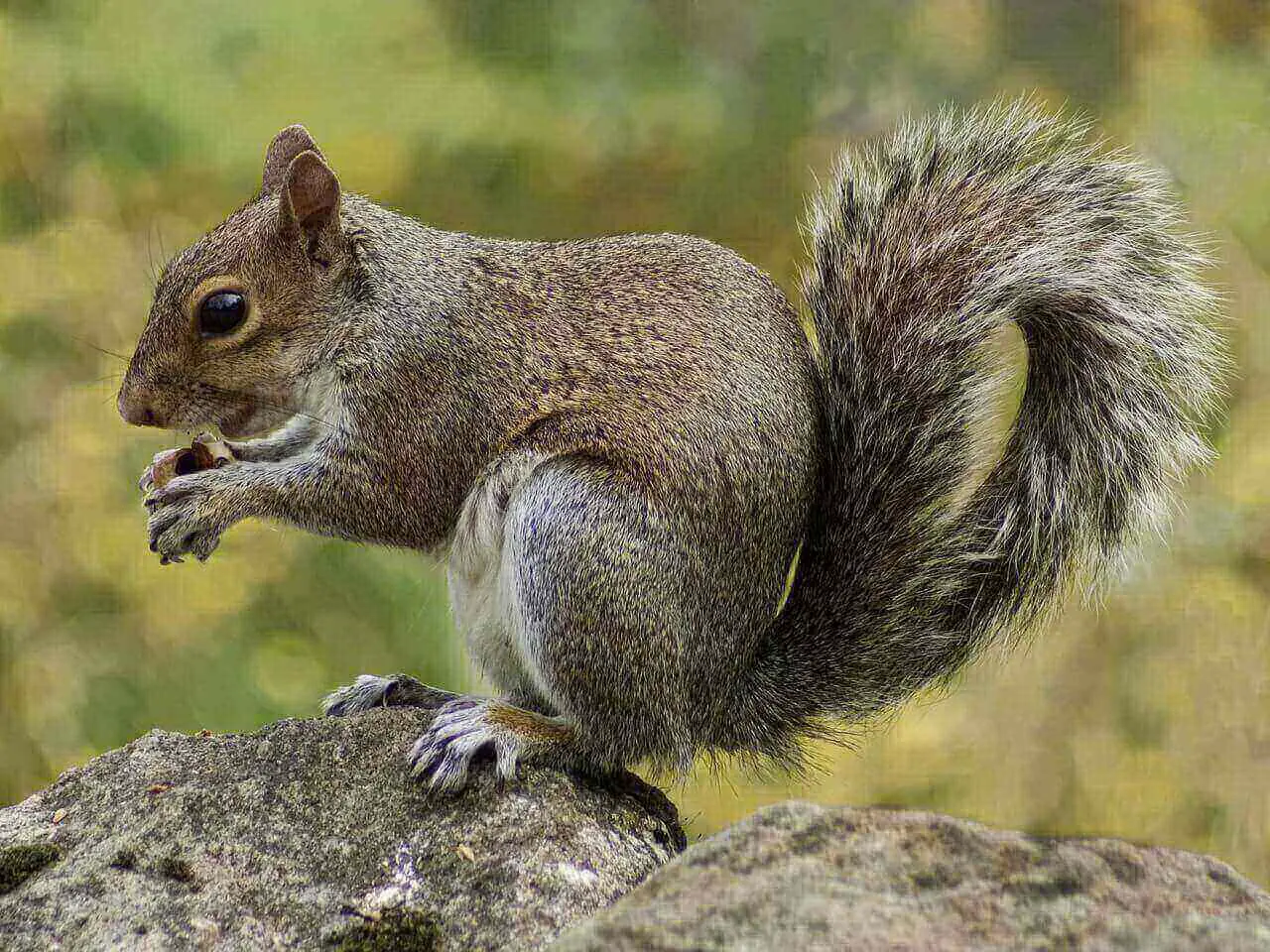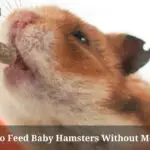At times, it can be challenging to tell for sure whether a baby squirrel is dying. In this article, you will find information on the signs through which you can tell when a baby squirrel is dying. You will also find information on what you can do, to save a baby squirrel that is dying.
This is how to tell if a baby squirrel is dying: by looking at its appearance and its behavior. A dying baby squirrel will normally be lethargic, cold, often with discharges from its body and sometimes with diarrhea or passing blood. The squirrel may also have seizures or spasms, breathing difficulties and baldness or spots on its skin.
Common causes of death in baby squirrels include disease, injuries, dehydration and malnutrition.

How to save a baby squirrel from dying will depend on what seems to be killing it. Therefore it may entail treating any underlying diseases or injuries, rehydrating the baby squirrel or providing it with proper nutrition.
Sometimes, reuniting a dying baby squirrel with its mother is all you need to do, to save it.
How Do You Know If A Baby Squirrel Is Dying?
If you want to know how to tell if a baby squirrel is dying, there are two key things to look at. Firstly, you look at the baby squirrel’s behavior. And secondly, you look at the baby squirrel’s appearance.
All signs of a dying baby squirrel are either things to do with its behavior or its appearance.
Let us start with dying or sick baby squirrel behavior.
Firstly, you tend to find a lot of lethargy in dying baby squirrels. Squirrels are normally fast, high energy animals. Therefore if you ever find a lethargic squirrel, especially a lethargic baby squirrel, it may be dying. That is unless it is in ‘hibernation’ mode.
Sometimes the lethargy may be extreme: like where you find the baby squirrel not moving but breathing.
Therefore the whole thing is about the baby squirrel acting strange. For instance, other than being lethargic, it may be having spasms. Baby squirrel spasms are often an indicator that the squirrel in question is dying.
In fact, many cases of sudden death of baby squirrel are preceded by spasms.
There are also those who report hearing a dying squirrel sound: which may be something akin to a shriek.
Therefore if a baby squirrel is lethargic, has spasms and makes that sort of shrieking sound, it may be dying.
Turning to the appearance aspect, it is common to find a dying baby squirrel bleeding from mouth.
The color of the baby squirrels that are dying may also change: from dark pink to grayish pink.
In fact, most of the people who pose the what are the signs of a dying squirrel question are often advised to start by looking at the color. If it is turning from dark pink to grayish pink, the squirrels may indeed be dying.
Discharges, Coldness And Baldness
Another common sign that a baby squirrel is dying is if it has abnormal discharges. The discharges may come out of the squirrel’s nose, mouth or even ears.
Coldness is yet another common sign of a dying baby squirrel. For instance, if you find a cold and stiff nearly dead baby squirrel, then indeed it may be dying.
If a baby squirrel has bald spots on its body, then it may be dying. This sort of baldness may be one of the longer term predictors that a baby squirrel is dying.
So it is unlike things like lethargy, spasms, breathing difficulties and so on: which tend to manifest just when the squirrel is about to die.
Balding is the sort of sign that can give you ‘notice’ that your baby squirrel is dying while there is still time to do something about it.
How Do You Know If A Baby Squirrel Is Sick?
Quite often, the signs of a baby squirrel dying overlap with the signs of a baby squirrel that is sick. This is because the baby squirrels often start out sick (often mildly so), before they eventually start dying.
Therefore in any discussion on how to tell if a baby squirrel is dying, it is essential to also discuss this aspect – of how to tell when a baby squirrel is sick.
If you can tell when a baby squirrel is sick in good time, and take the right corrective measures, then it may never get to the dying stage.
So, how do you tell if a baby squirrel is sick?
Again, the answer is by looking at the squirrel’s behavior and appearance.
For instance, if a baby squirrel that is always energetic becomes slow, weak and/or lethargic, then it may be sick.
If a baby squirrel that usually has a good appetite loses it, then it may be sick.
Further, if a baby squirrel that usually has a bright pink appearance starts turning gray, it may be sick.
Mouth, nose and ear discharges may also be indicative of a sick baby squirrel. So may things like spasms, coughing and breathing difficulties.
Sometimes, we actually have baby squirrels going limp like dead when they are seriously ill.
The specific signs of sickness may also depend on the illness that is manifesting…
If, for instance, it is a dehydration issue, you will notice that when you pinch the squirrel’s skin, it takes lots of time to go back to its normal state (tenting effect).
So that is how to tell if a baby squirrel is dehydrated.
Where you have a baby squirrel not moving but breathing, it may be an indication that it is sick – and possibly dying.
Is It Common For Baby Squirrels To Die?
Quite often, alongside the question on how to tell if a baby squirrel is dying comes this one: on whether it is common for baby squirrels to die.
The true position is this: it is quite common for baby squirrels to die. That is especially so for the first two weeks of their lives.
This is in fact why people who rear them are advised not to get too attached to them for those first two weeks. That is because they have a very high tendency to die at that stage.
Therefore if you are losing baby squirrels at an alarming rate at that stage (in the first two weeks of their lives), then you need to know that you are not alone. It is something that happens often.
But past the two week mark, baby squirrels tend to manage quite well.
All in all, there are many things that can potentially kill baby squirrels. The baby squirrels are rather delicate. Therefore it is quite common for them to die.
It is also for this reason that the question on how to tell if a baby squirrel is dying is a relatively common one.
That question is actually as common as the how to tell if a chipmunk is dying one – because the rates of dying for baby squirrels and chipmunks tend to be almost similar.
What Are The Common Causes Of Death In Baby Squirrels?
Anyone who wants to know how to tell if a baby squirrel is dying may also have an interest in knowing the common causes of death in baby squirrels.
Knowing the common causes of death can be helpful, when it comes to figuring out how to tell if a baby squirrel is dying.
Now the common causes of death in baby squirrels include diseases, injuries, dehydration and malnutrition.
Diseases that commonly kill baby squirrels include the likes of hypocalcaemia, metabolic bone disease, squirrel pox, plaque and encephalomyocarditis.
Injuries that may kill baby squirrels include those that they incur while running around, those from electric shocks, those from predator attacks and so on.
Dehydration is due to lack of adequate water/moisture whereas malnutrition is due to lack of adequate/proper food.
Ultimately, when figuring out how to tell if a baby squirrel is dying, you should keep it at the back of your mind that these are the common causes of death in baby squirrels.
Actually, the relevance of this goes beyond how to tell if a baby squirrel is dying.
Even when it comes to figuring out how to save a dying baby squirrel, knowledge of these common causes of death in baby squirrels would still be relevant.

Do Squirrels Play Dead?
Sometimes, the people seeking to know how to tell if a baby squirrel is dying will want to know whether squirrels play dead.
The true position is that squirrels never play dead. That is unless they are in ‘hibernation’ mode: where they sleep a lot and generally slow down. Even then, they don’t truly ‘play dead’ like other hibernating animals.
Outside the ‘hibernation’ mode, squirrels never play dead.
Therefore if you have a squirrel that looks dead, yet it is not hibernating, then you need to know that it is either indeed dead or dying.
How Do You Tell If A Baby Squirrel Is Dying Or Hibernating?
How to tell if a baby squirrel is dying or hibernating is quite simple.
Firstly, how can you tell if a baby squirrel is dying? As we said earlier, that is by looking at its behavior and appearance.
A dying baby squirrel will normally be lethargic. It will also sometimes have spasms, coughing or breathing difficulties. The squirrel’s color may become grayish. And it will usually have bald spots on its skin.
Further, a dying baby squirrel may have less appetite, be somewhat cold to touch and have discharges from its mouth, nose and possibly ears.
On the other hand, a ‘hibernating’ baby squirrel will tend to sleep a lot, be less active and also have somewhat less appetite.
We put the word ‘hibernating’ in quotes because squirrels don’t actually hibernate in the true sense of the word. They just slow down during the winter months. So they spend lots of time sleeping, but still responsive.
Now if, for instance, you find a baby squirrel having spasms, you know that it is not hibernating. It is probably dying.
If you find a baby squirrel with nose, mouth or ear discharges, you know that it is not hibernating. It is probably dying.
Or if you find a baby squirrel having bald spots on its fur, you know that it is not hibernating. It is probably dying.
How To Tell If A Squirrel Is Dead, Dying, Or In Shock?
How to tell if a baby squirrel is dying, in shock or dead is quite straightforward.
Let’s start with how to tell if a baby squirrel is dying. As noted earlier, the symptoms include lethargy, baldness, graying, coldness (to touch) and spasms.
Others include having nose, mouth and ear discharges, having diarrhea or passing blood.
Now let’s turn to how to tell if a baby squirrel is in shock.
A baby squirrel that is in shock will tend to have rapid breathing. Its heart pulse will also tend to be fast. A baby squirrel that is in shock will normally not respond to touch. And its eyes will usually be staring in a firmly fixed manner.
Those are the key baby squirrel in shock symptoms.
Finally, let’s look at how to tell if a baby squirrel is dead.
Now a dead baby squirrel will be completely unresponsive to even the strongest of touch stimuli – including pokes.
It will also tend to be cold – completely cold, in an inanimate manner. And it will typically be completely stiff, again in an inanimate manner. Of course, it will have no pulse or respiration.
Clearly then, how to tell if a baby squirrel is dying, in shock or dead is quite simple.
For instance, if a dying squirrel still has a heart pulse, an already dead baby squirrel doesn’t have one.
If a dying squirrel may still be respiring (perhaps with difficulties, but still respiring), a dead one won’t respire at all.
Whereas a dying squirrel may respond to touch, one that is either in shock or dead won’t respond to touch. So how to tell if a baby squirrel is dying, dead or in shock is quite easy, once you understand the differences.
What To Do With A Dying Squirrel?
Ideally, what you need to do is figure out how to help a dying squirrel. And how to save a dying squirrel typically depends on what seems to be killing it.
Where, for instance, it seems to be disease, you need to have a vet diagnose it and treat it appropriately.
But what of cases where the problem seems to be hunger? For instance, how do you save a baby squirrel from dying of hunger?
The first thing here is to figure out how to tell if a baby squirrel is hungry. So, for instance, you try to understand, what do squirrels do when they are dying of starvation?
And the answer is that they may become lethargic, develop bald spots on their skins, start turning gray and lose weight rapidly…
Once you ascertain that the problem is hunger, then how to save a baby squirrel from dying of it becomes easy.
In most cases, all you have to do is give the baby squirrel puppy milk, in order to rejuvenate it.
Where the squirrel seems to be dying from dehydration, rehydration is the answer. This you can do using something like the pedialyte solutions.
In a case where the squirrel seems to be dying from injuries, focus should be on treating those injuries. Now injuries that are serious enough to kill a baby squirrel may be best treated by a vet.
But what of where the squirrel seems to be dying from old age? Do squirrels die of old age by the way (though our focus is on baby squirrels)? Squirrels, like all other animals, may die from old age.
And where old age seems to be the reason why the squirrel is dying, then all you may be able to do is provide compassionate support.
Final Verdict – How To Tell If A Baby Squirrel Is Dying
To tell if a baby squirrel is dying, you need to look at its behavior and appearance.
A baby squirrel that is dying will normally be lethargic. It may also have mouth, nose and perhaps ear discharge, as well as diarrhea. In some cases, it may be passing blood.
Further, a baby squirrel that is dying may cough, have spasms or breathing difficulties. In terms of appearance, it may start turning gray, and perhaps become bald or have spots on its skin.
Common causes of death in baby squirrels include diseases and injuries: including those from falls, electric shocks and those from predator attacks. Other causes are dehydration and malnutrition.

Sometimes, it may be possible to save a baby squirrel from dying. Where the problem seems to be a disease, having a vet diagnose and treat it may be the solution.
Where the problem seems to be injury, vet treatment can also be useful. And where the problem seems to be malnutrition, provision of food (including puppy milk for the youngest baby squirrels) may be the solution.
Finally, where the problem seems to be dehydration, the solution is typically rehydration. That is achievable through something like the pedialyte solution.
As a pet lover, make sure to learn about pet more and give your pet squirrel a good and comfortable life!

Welcome to Learn About Pet. My name is Rajkumar Ravichandran and I love all pets, travel, and amazing food. I write about my passion and personal experience caring for multiple pets in this blog! ❤️
Post Disclaimer
DISCLAIMER: THIS BLOG OR WEBSITE, "Learn About Pet", DOES NOT PROVIDE YOU WITH MEDICAL ADVICE AND IS NOT A SUBSTITUTE FOR MEDICAL ADVICE. ALWAYS GET IN TOUCH WITH YOUR PERSONAL VETERINARIAN AND USE INFORMATION HERE AS GENERAL ADVICE.
The information, including but not limited to, text, graphics, images and other material contained on this website are for informational purposes only. No material on this site is intended to be a substitute for professional veterinary advice, food recommendation, diagnosis, or treatment. Always seek the advice of your veterinarian or other qualified health care provider with any questions you may have regarding a medical condition or for pet food related questions.







